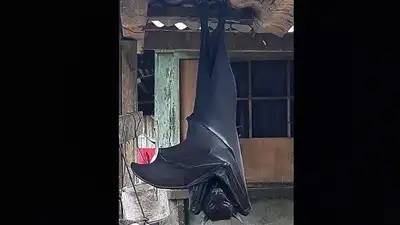ARTICLE AD BOX

A viral photo of a massive bat in the Philippines recently resurfaced, sparking renewed interest online. While the image isn't fake, it's an optical illusion created using forced perspective. The bat is a giant golden-crowned flying fox, a real species with a wingspan of up to 5.5 feet.
Social media platforms are a place where any photo or video can go viral instantly, but sometimes the photos or videos shared online might be contrary to what they look like in reality!

Photo via X
Is this even real?
A frightening photo of a massive bat clinging to a wire in the Philippines had gone viral in 2018, and recently it gained reaction again, this time on X, where it garnered thousands of likes after being shared by multiple users on the social media platform.
The truth behind the viral Image
Contrary to rumors, the image isn’t fake. The bat in question is very real and belongs to a genuine species. Fact-checking site Snopes confirms it depicts an actual animal known as the giant golden-crowned flying fox, also called the golden-capped fruit bat, native to the Philippines.Despite its fearsome appearance, the bat isn’t human-sized. The wingspan can reach up to 5.5 feet, but its body measures only about 1 foot in height, making it large for a bat, but far from human proportions.
The image is an optical illusion!
The size of the bat looks almost unreal due to forced-perspective photography, a technique that manipulates camera angles to make objects appear larger or smaller than they really are. Just like tourists pretend to hold up the Leaning Tower of Pisa or keep their hands on the tip of the Taj Mahal, this bat simply benefits from a similar optical illusionA commenter from the Philippines commented on this photo posted by '@AlexJoestar622': “They have a huuuuuge wingspan but the bodies are not really that big, more or less like the same body as a medium (bit smaller) sized dog… they’re really gentle too.”
This gentle giant is endangered and fruit-loving
The giant golden-crowned flying fox is one of the world’s largest bats, native to the Philippines. With a wingspan of up to 5.5 feet and a body about 1 foot long, it may look terrifying, but it’s a gentle, fruit-eating species that requires our protection and poses no harm to humans, but is sadly endangered, because its survival is threatened by deforestation and hunting for meat.The photo may jar one’s imagination, but it also reminds us how easily visuals can be misleading.



.png)
.png)
.png)
















 2 hours ago
5
2 hours ago
5







 English (US) ·
English (US) ·